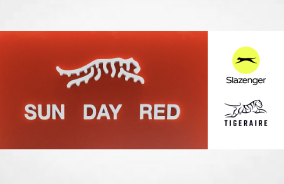
The recent launch of Tiger Woods’ new clothing line, “Sun Day Red,” has ignited something of a debate in the worlds of golf and trademark law. The collection, which features the iconic red attire Woods is known for wearing on tournament Sundays, has drawn attention not just for its association with the legendary golfer, but also for its logo, which bears a striking resemblance to existing trademarks in the golf industry.
At the heart of the matter is the “Sun Day Red” logo, which prominently features a tiger – an obvious nod to Woods’ personal brand. However, this design choice has not gone unnoticed by observers in the golf world, who were quick to point out similarities between the new logo and that of Slazenger, a long-established name in golf equipment and apparel.
Slazenger, which has been a staple in the golfing world since the 1800s, has held trademarks for various versions of its name and its signature black panther logo since 1988. Despite the apparent similarities, as of this writing, Slazenger has not filed any infringement claims against “Sun Day Red.”
Instead, it was Tigeraire, a lesser-known brand, that took the first legal step by filing a notice of opposition with the United States Patent and Trademark Office (USPTO) against the “Sun Day Red” logo. Tigeraire claims that Tiger and TaylorMade “seek[s] to increase its sales and profits by unlawfully hijacking Tigeraire’s registered design”. This move has brought to light the intricacies of trademark law and its application in the sports industry.
The primary legal issues at stake revolve around potential trademark infringement. In such cases, the USPTO examines two key factors: 1) the similarity of the marks; and 2) the relatedness of the goods or services associated with them. Their main goal is to prevent consumer confusion in the marketplace.
When comparing the marks, it’s difficult to overlook the resemblance between Sun Day Red’s tiger image, Tigeraire’s tiger image, and the panther in Slazenger’s logo. While Slazenger’s logo features a different species of cat, it’s important to note that in trademark law, the use of feline imagery is often considered broadly, rather than distinguishing between specific species.
Regarding the relatedness of goods and services, both Slazenger and Sun Day Red operate in the golf apparel and accessories market, suggesting a direct relation. Tigeraire’s situation is more nuanced; their trademark is registered for “portable electric fans,” which, while potentially used in golfing contexts, is not explicitly golf-related in its class description.
The USPTO’s evaluation process typically involves examining similarities between the applied-for mark and existing registered marks, assessing the likelihood of consumer confusion, and considering the commercial impression of the marks. It’s noteworthy that the similarity between Sun Day Red and existing marks, particularly Slazenger’s, was not flagged during the initial USPTO review process.
This case highlights several interesting aspects of trademark law in the context of celebrity branding. The power of association between a public figure like Tiger Woods and certain words or images (in this case, “Tiger” and feline imagery) can complicate trademark disputes. The fact that Tigeraire, rather than the more established Slazenger, filed the opposition demonstrates that trademark protection is not limited to industry giants.
As this situation unfolds, it serves as a reminder of the complexities involved in trademark law, especially when dealing with high-profile brands and figures in specialized industries. Furthermore, it underscores the importance of thorough trademark searches and taking careful consideration of existing marks in related industries before launching a new brand.
The outcome of this dispute may provide valuable insights for future trademark strategies in the sports and apparel sectors. It also illustrates the delicate balance that must be struck between leveraging a celebrity’s personal brand and respecting existing trademarks in the industry.
For legal professionals and brand managers alike, the Sun Day Red case offers a compelling study in the nuances of trademark law and the challenges of navigating brand identity in a crowded marketplace. As the golf world watches this legal drama unfold, it’s clear that the implications of this case could extend far beyond the fairways and greens.
[View source.]
Source: JD Supra
https://www.jdsupra.com/legalnews/trademark-tee-off-tiger-s-new-brand-in-8120220/





